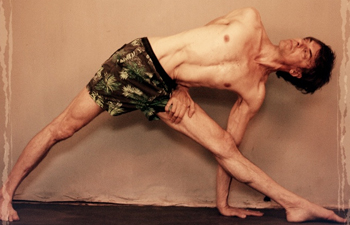
There is a sacred text called the Vijnana Bhairava, a gift from the God Shiva, and in it Shiva gives a set of yantras or images that are to be repeatedly held in the mind as devices for meditation. Several of these yantras revolve around contemplating the body as having nothing inside of it. You are to meditate upon the concept that you are space or emptiness. Structures that make up your body, such as your bones, muscles, organs, and vessels, only appear to be solid and have mass but when you use awareness to penetrate through to their deeper essence you will find no solidity, nothing at all substantial or lasting. Meditating on the vastness of the interior realms within you will reveal that between the layer of skin that superficially surrounds your entire body and the marrow of your bones that are hidden deep within your core you find enough space to house millions upon millions of parallel universes. As a yogi you contemplate your interior space as void, empty, or without form, in order to know all form as without substance. You cause your mind to mirror the quality of spaciousness as a means to creating silence and stillness in your poses. Practice reveals that your arms, legs, pelvis, torso, and head all share the common essense of space.
Using the contemplation of space to enter silence and stillness gives you an effective means of stopping unnecessary, habitual, gross and subtle movements in your asana practice. For example, you can create a feeling of infinite space in Downward Facing Dog, by rooting down through your hands and feet, stabilizing your arms and legs, and then creating infinite extension along your arms, legs, and spine. Since your pose is silent, steady, and spacious you are able to detect and eliminate all manner of tiny habitual shifts and extraneous movements in your body and mind. By fastening your attention onto the element of space you see all movement as a disturbance, an unwanted interruption to the flow of internal awareness that you have created.
In practice, whether staying in an asana or moving through transition positions, your mind can be so razor sharp that you swiftly cut away movements that do not belong. Repetition of a movement or posture is meant to teach you to arrive in a meditative state without preamble. Since you have rehearsed the act of setting up a pose, including variables such as skeletal positioning, breathing protocol, and rhythm, you can move into position with a swift, sure, and complete move. You strike the pose in an instant and become as still as a statue. By utilizing the gesture you come to understand that there is a difference between going fast and hurrying. Becoming impatient or rushing is not what you want, but rather to clip along, flowing with purity through your vinyasa positions, executing transitions with lickety split nimbleness and yet remaining steady, silent and ready to strike an immovable spot in any instant. You train yourself how to move fast and stop fast, to switch between being fully in motion and utterly still with seamless fluidity. By using this technique you can create a state of meditation as fast as you can wink.
One way to expand the definition of meditation is to allow your self the freedom to find stillness in any position, at any time, and for any length of time. You give yourself permission to cherish any position that brings stillness no matter how unlikely, unorthodox or uncommon the position. The only essential criterion for any position is to arrive in the present moment somehow and create a flow of sustained internal awareness. Don't give anyone the power to decide for you what constitutes a state of meditation. The only rule that applies is that you find an immovable position and enjoy a diamond clear pause, and in this moment, above all else, you value bringing activity to a stop.
Comments
No comments.